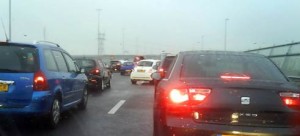On the wrong way
A number of trends and issues directly affect mobility or caused by it.
- Congestion: there is a lot traffic, especially passenger traffic. The car is obviously unsuitable for mass transport. Is it wise to spend more on additional roads and consequently maintenance costs for only one person per car?
- Car parking: the cities already lack parking spaces for the car. Every car needs a parking space at the place of departure as well on the destination. How much more living, playing or building space must be sacrificed for parking spaces?
- Bicycle parking: at the larger stations it is already difficult to find a bicycle parking space. A number of bicycles are obviously parked for more than one day. How can travellers then still combine bicycle and trains?
- Disjointed public transport: poor connections and lack of cooperation between transport operators, information services and government waste a lot of time of the traveler. How can we make a complete package of our public transport?
- Reasonably functioning public transport:
despite all shortcomings the public transport functions not bad enough. In other words; good enough to keep deferring substantial improvements. So how can we get long term improvements for the public transport? - Low return on total investment: roads are widened, some rail lines doubled, but there is no incentive for a large-scale behavior change of the traveler. The hence created additional capacity quickly disappears in the next bottleneck. How can we get more value for our money?
